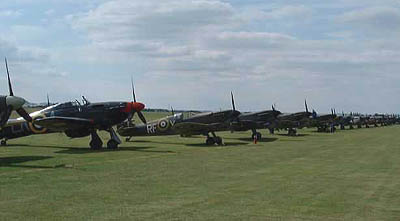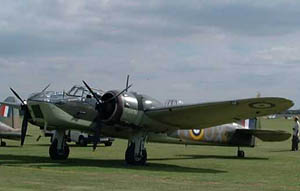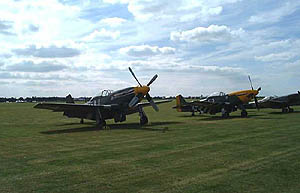Battle of Britain 60th Anniversary  Airshow Airshow
Duxford, 9/10 SeptemberIan Herbert reports: Although
living 150 miles away up in Yorkshire, the promise of twenty-odd Spitfires and a fair few
Hurricanes made the two and a half hour journey pale into insignificance - this was one
Airshow I just couldn't miss. And what a sight to be greeted with at the end of a long
journey - a line of Spitfires, Hurricanes and other assorted warbirds stretching almost as
far as the eye could see. A couple of trips up and down the flight line and a few photos
later, it was time to make my way back behind the barriers and (try) to get a decent
viewing spot, which was easier said than done.
So on to the flying display. A Harrier GR7 of the RAF was the first aircraft to do its
stuff. Not exactly Battle of Britain material, but pretty spectacular. From this, the pace
changed to being slightly more sedate, with various WW1 fighters, including a Fokker
Triplane, Sopwith Triplane, Bristol Fighters and an Avro 504. As their display slot  was drawing
to a close, the sound of Merlins spluttering into life could be heard coming from the long
line of Warbirds. Instantly, the whole crowd turned to look towards the line to be greeted
by the glorious sight of three Spitfires and three Hurricanes taxiing out towards the
grass strip runway. As they took to the air, the crowd was rewarded with the wonderful
sound of six of Rolls-Royce's finest working together. A fairly impressive display
followed, with the aircraft showing their manoeuvrability as the pilots started having
fun. All too soon, though, they were coming in for finals and taxiing back to their slot
in the impressive flight line. was drawing
to a close, the sound of Merlins spluttering into life could be heard coming from the long
line of Warbirds. Instantly, the whole crowd turned to look towards the line to be greeted
by the glorious sight of three Spitfires and three Hurricanes taxiing out towards the
grass strip runway. As they took to the air, the crowd was rewarded with the wonderful
sound of six of Rolls-Royce's finest working together. A fairly impressive display
followed, with the aircraft showing their manoeuvrability as the pilots started having
fun. All too soon, though, they were coming in for finals and taxiing back to their slot
in the impressive flight line.
An aircraft that shouldn't be forgotten was the British Aerial Museum's Blenheim, the only
flying example in the world, looking great in 82 Squadron markings. It was a real
privilege to be able to see something so rare being put through its paces.
 Next came the American slot. B-17 "Sally B"
coughed into life, and covered me and numerous others in oily smelling white smoke as each
of the engines were started in turn. The other American participants were two P-51s and a
P-47 Thunderbolt. Once they were all airborne, the P-51s flanked the B-17 while the P-47
did a solo display. The 'Jug' pilot must have had something in his tea before he took off,
as he threw it through a spectacularly testing display routine that belied the aircraft's
size. Next came the American slot. B-17 "Sally B"
coughed into life, and covered me and numerous others in oily smelling white smoke as each
of the engines were started in turn. The other American participants were two P-51s and a
P-47 Thunderbolt. Once they were all airborne, the P-51s flanked the B-17 while the P-47
did a solo display. The 'Jug' pilot must have had something in his tea before he took off,
as he threw it through a spectacularly testing display routine that belied the aircraft's
size.
 A nice interruption in the warbird theme was the Meteor and Hunter display,
which involved some fast, low passes from both before they departed. Great to see these
old aircraft still flying. A display from a Sea Harrier again took the focus off Warbirds,
and also put the RAF's GR7 display to shame, showing off the aircraft's hovering
characteristics much better, although the noise levels were much the same!!! As the flying
programme began to draw to a close, pilots started going out to their aircraft, in
preparation for the spectacle that everyone was looking forward to see, the mass formation
flypast. And so one after another, the assembled Spitfires and
Hurricanes taxied out to the runway. Taking off in threes, they all took to the sky and
disappeared to the North while four gloss black Hawks from 19
Squadron, normally based at Valley, tried to emulate the Red Arrows in a pretty impressive
display of formation flying. A nice interruption in the warbird theme was the Meteor and Hunter display,
which involved some fast, low passes from both before they departed. Great to see these
old aircraft still flying. A display from a Sea Harrier again took the focus off Warbirds,
and also put the RAF's GR7 display to shame, showing off the aircraft's hovering
characteristics much better, although the noise levels were much the same!!! As the flying
programme began to draw to a close, pilots started going out to their aircraft, in
preparation for the spectacle that everyone was looking forward to see, the mass formation
flypast. And so one after another, the assembled Spitfires and
Hurricanes taxied out to the runway. Taking off in threes, they all took to the sky and
disappeared to the North while four gloss black Hawks from 19
Squadron, normally based at Valley, tried to emulate the Red Arrows in a pretty impressive
display of formation flying.
 And so the
time came for one of the most impressive sights you're ever likely to see at an airshow -
twenty Spitfires and three Hurricanes all in the same place at the same time. They all
came from the North, in formation, and then the groups of three banked off and came round
to pass over the airfield separated at five second intervals. Looking to the skies that
day you could have been forgiven for thinking that time had gone back sixty years -
fitting, given the title of the airshow. And so the
time came for one of the most impressive sights you're ever likely to see at an airshow -
twenty Spitfires and three Hurricanes all in the same place at the same time. They all
came from the North, in formation, and then the groups of three banked off and came round
to pass over the airfield separated at five second intervals. Looking to the skies that
day you could have been forgiven for thinking that time had gone back sixty years -
fitting, given the title of the airshow.
 The only dampener to the day were the prices...an extortionate £20 entry fee,
£4 for a programme, £3 to get onto the flight line...the list goes on. Those people at
the IWM certainly know how to charge...The only thing that made the cost a slightly less
bitter pill to swallow was the fact that you were free to look round the whole of the
Museum, and see its truly astonishing collection of aircraft. The only dampener to the day were the prices...an extortionate £20 entry fee,
£4 for a programme, £3 to get onto the flight line...the list goes on. Those people at
the IWM certainly know how to charge...The only thing that made the cost a slightly less
bitter pill to swallow was the fact that you were free to look round the whole of the
Museum, and see its truly astonishing collection of aircraft.
So all in all, the show was a fitting tribute to all the airmen who fought for Britain
sixty years ago, to who we should always be grateful.
As we reflect on the anniversary of
the Battle of Britain, an amusing anecdote of how the Poles were converted onto RAF
aircraft has come to light. As the training squadron took off, watching CFS wallah turns
to Polish adjutant and says: "Fine bunch of chaps. Did frightfully well, even those
who couldn't speak English. Except one - Major Xyzrytry (or whatever). Didn't seem to get
the hang of a Hurricane at all at first. You'd have thought he was a bomber pilot
before!" Polish Adj: "No. A navigator!" And that, apparently, is true! Said
Pole went on to score several kills and reached 1945 as a Wing Commander!
With thanks to http://www.pprune.org/.
|
 Airshow
Airshow was drawing
to a close, the sound of Merlins spluttering into life could be heard coming from the long
line of Warbirds. Instantly, the whole crowd turned to look towards the line to be greeted
by the glorious sight of three Spitfires and three Hurricanes taxiing out towards the
grass strip runway. As they took to the air, the crowd was rewarded with the wonderful
sound of six of Rolls-Royce's finest working together. A fairly impressive display
followed, with the aircraft showing their manoeuvrability as the pilots started having
fun. All too soon, though, they were coming in for finals and taxiing back to their slot
in the impressive flight line.
was drawing
to a close, the sound of Merlins spluttering into life could be heard coming from the long
line of Warbirds. Instantly, the whole crowd turned to look towards the line to be greeted
by the glorious sight of three Spitfires and three Hurricanes taxiing out towards the
grass strip runway. As they took to the air, the crowd was rewarded with the wonderful
sound of six of Rolls-Royce's finest working together. A fairly impressive display
followed, with the aircraft showing their manoeuvrability as the pilots started having
fun. All too soon, though, they were coming in for finals and taxiing back to their slot
in the impressive flight line. Next came the American slot. B-17 "Sally B"
coughed into life, and covered me and numerous others in oily smelling white smoke as each
of the engines were started in turn. The other American participants were two P-51s and a
P-47 Thunderbolt. Once they were all airborne, the P-51s flanked the B-17 while the P-47
did a solo display. The 'Jug' pilot must have had something in his tea before he took off,
as he threw it through a spectacularly testing display routine that belied the aircraft's
size.
Next came the American slot. B-17 "Sally B"
coughed into life, and covered me and numerous others in oily smelling white smoke as each
of the engines were started in turn. The other American participants were two P-51s and a
P-47 Thunderbolt. Once they were all airborne, the P-51s flanked the B-17 while the P-47
did a solo display. The 'Jug' pilot must have had something in his tea before he took off,
as he threw it through a spectacularly testing display routine that belied the aircraft's
size. A nice interruption in the warbird theme was the Meteor and Hunter display,
which involved some fast, low passes from both before they departed. Great to see these
old aircraft still flying. A display from a Sea Harrier again took the focus off Warbirds,
and also put the RAF's GR7 display to shame, showing off the aircraft's hovering
characteristics much better, although the noise levels were much the same!!! As the flying
programme began to draw to a close, pilots started going out to their aircraft, in
preparation for the spectacle that everyone was looking forward to see, the mass formation
flypast. And so one after another, the assembled
A nice interruption in the warbird theme was the Meteor and Hunter display,
which involved some fast, low passes from both before they departed. Great to see these
old aircraft still flying. A display from a Sea Harrier again took the focus off Warbirds,
and also put the RAF's GR7 display to shame, showing off the aircraft's hovering
characteristics much better, although the noise levels were much the same!!! As the flying
programme began to draw to a close, pilots started going out to their aircraft, in
preparation for the spectacle that everyone was looking forward to see, the mass formation
flypast. And so one after another, the assembled  And so the
time came for one of the most impressive sights you're ever likely to see at an airshow -
twenty Spitfires and three Hurricanes all in the same place at the same time. They all
came from the North, in formation, and then the groups of three banked off and came round
to pass over the airfield separated at five second intervals. Looking to the skies that
day you could have been forgiven for thinking that time had gone back sixty years -
fitting, given the title of the airshow.
And so the
time came for one of the most impressive sights you're ever likely to see at an airshow -
twenty Spitfires and three Hurricanes all in the same place at the same time. They all
came from the North, in formation, and then the groups of three banked off and came round
to pass over the airfield separated at five second intervals. Looking to the skies that
day you could have been forgiven for thinking that time had gone back sixty years -
fitting, given the title of the airshow. The only dampener to the day were the prices...an extortionate £20 entry fee,
£4 for a programme, £3 to get onto the flight line...the list goes on. Those people at
the IWM certainly know how to charge...The only thing that made the cost a slightly less
bitter pill to swallow was the fact that you were free to look round the whole of the
Museum, and see its truly astonishing collection of aircraft.
The only dampener to the day were the prices...an extortionate £20 entry fee,
£4 for a programme, £3 to get onto the flight line...the list goes on. Those people at
the IWM certainly know how to charge...The only thing that made the cost a slightly less
bitter pill to swallow was the fact that you were free to look round the whole of the
Museum, and see its truly astonishing collection of aircraft.